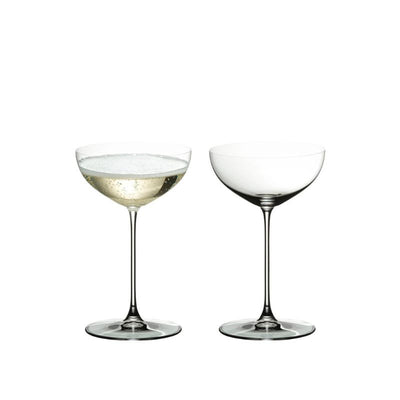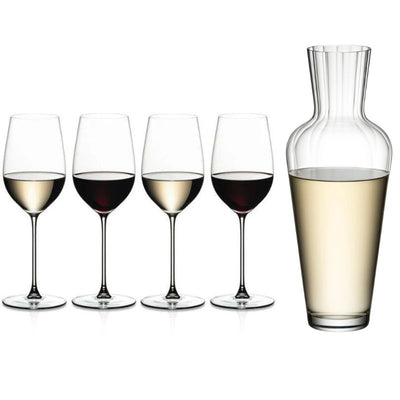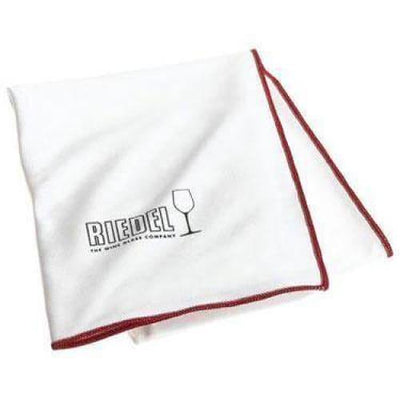Bordeaux: And Why Everyone Gets So Worked Up About It

I dropped lucky this week. When Andrew (The Boss) was in the office, on Tuesday morning, Paul casually asked him what he was planning to write about in his Art of Living missive this week. When the answer came back as the "Riedel Superleggero Bordeaux glass", my ears pricked up as I knew that a rummage through my notes would reveal a piece about Bordeaux, that I'd pretty much already written. Result!
That was the good news for me. The good news for you is that Andrew was so impressed with the new machine made Superleggero glasses (more of his thoughts later) that, for this week, you can buy 2 for £69.00, which is just over 27% off the RRP, with code SUPER25.
Bordeaux: Why Everyone Gets So Worked Up About It
There's something about Bordeaux that makes perfectly sensible people go a bit peculiar.
Mention it in wine shops and suddenly everyone's speaking in hushed tones about Left Bank versus Right Bank, vintages, and classifications. It's like there's some secret knowledge you're supposed to have absorbed through osmosis.
The reality is actually much simpler than the wine snobs would have you believe. Bordeaux makes exceptional wine, has done for centuries, and the region has developed some helpful ways to navigate what can seem like an overwhelming number of choices.
Once you understand the basics, it becomes much less mysterious and much more enjoyable.
Geography That Actually Matters
Bordeaux sits where two rivers meet - the Dordogne and the Garonne - creating the Gironde estuary. This geography matters because it creates distinctly different growing conditions on either side.
|
The Left Bank includes the Médoc and Graves regions. The soil here is gravelly, which Cabernet Sauvignon loves. These wines tend to be more structured and powerful - think Margaux, Saint-Julien, Pauillac, and Saint-Estèphe. The Right Bank covers Saint-Émilion and Pomerol. Clay and limestone soils here favour Merlot, producing wines that are generally softer and more approachable when young. So, the Left and Right Bank differentiation isn't wine snobbery - it's practical information. If you like wines with plenty of structure and don't mind waiting a few years for them to soften, Left Bank might be just your style. If you prefer wines that are ready to drink sooner rather than later, then head to starboard. |
Then, just because it can't be quite that simple, there's the Entre-deux-Mers - literally "between two seas" - the large area between the rivers. This is where much of Bordeaux's white wine comes from, primarily made from Sauvignon Blanc and Sémillon.
The wines here tend to be fresh, crisp, and remarkably good value.
The Entre-deux-Mers also produces red wine under the basic Bordeaux appellation, and these can be some of the region's best bargains. The area doesn't have the prestige of the famous Left and Right Bank chateaux, which means the wines are often priced more reasonably while still offering genuine Bordeaux character.
The Art of Blending
Unlike wines made from a single grape variety, Bordeaux is almost always a blend. The main players are Cabernet Sauvignon, Merlot, Cabernet Franc, with occasional appearances from Petit Verdot and Malbec.
This blending approach serves a practical purpose. When one variety has a difficult year due to weather, the others can compensate. It's why Bordeaux tends to be more consistent than you might expect from a region that experiences significant vintage variation.
Each grape brings something different. Cabernet Sauvignon provides structure and aging potential. Merlot adds softness and fruit. Cabernet Franc contributes spice and complexity. The skill lies in getting the proportions right for each vintage.
Decoding the Labels (Or: How Not to Look Lost in the Wine Shop)
The most important thing to understand is that Bordeaux labels don't tell you the grape varieties - they tell you where the wine comes from. This is because the French believe (probably correctly) that place matters more than grape variety. So instead of "Cabernet Sauvignon," you'll see "Pauillac" or "Saint-Émilion."
The hierarchy goes something like this:
- Bordeaux AOC: The basic level. Think of it as the reliable family saloon of Bordeaux wines.
- Bordeaux Supérieur: Slightly more stringent rules, usually a bit better.
- Specific appellations (like Margaux, Saint-Julien): The BMW and Audi sports cars.
- Classified Growths: (Lafite, Latour etc.) The Ferraris and Aston Martins of the wine world.
The labels themselves, helpfully, give us a lot of other information too.
 |
|
The 1855 Classification: Victorian Wine Snobbery at Its Finest
In 1855, Napoleon III asked Bordeaux wine merchants to rank their best wines for the Paris Exposition. Being French, they took this very seriously and created a classification system so rigid it makes the British class system look flexible.
They ranked 61 châteaux into five categories, from First Growth (Premier Cru) down to Fifth Growth (Cinquième Cru). The First Growths - Lafite, Latour, Margaux, Haut-Brion, and later Mouton Rothschild - became the wine equivalent of the aristocracy, with prices to match.
However, this classification was based on 1855 prices, and it's barely changed since. Some châteaux have probably improved dramatically, others might have rested on their laurels, but the classification remains largely set in stone.
It's like being permanently judged by your O Level results.
The Sweet Spot: What You (or certainly most of us) Can Actually Afford
Before you assume all good Bordeaux requires serious investment, consider this: there's excellent wine at every price level.
Bordeaux and Bordeaux Supérieur from good producers offer genuine quality at reasonable prices. These wines are designed to be enjoyed now rather than cellared for decades.
Cru Bourgeois represents the middle tier - more serious than basic Bordeaux but without the premium of classified growths. Many of these châteaux, such as Lalande-de-Pomerol or Saint-Georges-Saint-Émilion offer wines made in the style of their famous neighbours, at much more accessible prices.
The Glass Makes All the Difference
This is where I'm going to slip into my professional mode for a moment, because the right glass genuinely transforms Bordeaux from "nice wine" to "I understand why people write poetry about this stuff."
It isn't about being precious - it's about getting the most from what you've bought. Bordeaux wines are complex, with layers of aroma and flavour that need proper glassware to express themselves fully.
A good Bordeaux glass like the Riedel Superleggero Bordeaux isn't a luxury - it's practical equipment. The shape concentrates aromatics and delivers the wine to your palate in a way that maximises its potential.
This is what Andrew had to say about it this week. And, bear in mind, that he's been selling (and drinking from) Riedel glasses for the best part of 3 decades....
To set the scene, he's a Bordeaux fan and was given a number of very nice bottles at his recent birthday celebrations.
One such was presented to me, with the nonchalance that suggests this sort of thing happens every day, by Martin Turner, our Riedel account manager. It was a Chateau Pichon Longueville 2009, no less! And if that means nothing to you, 'Snap!', it didn’t to me either, until I researched it. It turns out, in quality and price, this is not a wine to appreciate alone, so I enlisted the help of two wine drinking chums, Casey and Adrian. Both of whom have far greater knowledge than me in these matters.
Riedel Superleggero Bordeaux Grand Cru
I got out my Riedel Superleggero Bordeaux Grand Cru glass given me by our “old” Riedel account manager, Matt Knight. I'd since acquired two more for the occasion, so the scene was set. The bowl on this glass, to misquote a well-known food critic, is a balloon of such audacious girth, that it needs its own postcode. This is, without doubt, the most impressive glass to drink your Bordeaux from that you are ever likely to come across. What stands out is the size and height of this eye-catching, super-light behemoth. With a capacity of over 950cc there's room for a whole bottle of wine and room to spare.
The Bordeaux glass that trumps all Bordeaux glasses. Needless to say, we had a delightful evening sampling the lush berry and slightly earthy tones that this remarkable wine reveals. Would it have tasted the same in my normal Riedel Cabernet/Merlot Veritas glasses?
I’m afraid I don’t know, because we were enjoying ourselves too much to try. But, I can tell you that I drink my standard St. Emilion (Bordeaux) out of the Veritas and whilst they are still an indulgence at £62.50 a pair (currently price matched at £49.95), they are no slouch in the taste stakes.
However, there is something rather special about the bath sized bowl that the Superleggero affords the experience.
Naturally the Superleggero are even more indulgent (than the Veritas) with an appropriate price tag of £47.50 each (currently price matched at £37.95).
But for this week I’m offering you the opportunity to buy two for £69.00.
Use code SUPER25 if shopping on the websites or, give us the nod if you’re are coming into the Cobham or Reigate shops.
I couldn't have put it better myself Andrew!
Young Bordeaux particularly benefits from decanting. Those firm tannins that can seem harsh in a newly opened bottle often soften beautifully with an hour of exposure. A Riedel Ultra decanter is brilliant for this, the wide base provides the surface area needed for this transformation.
When to Drink Your Bordeaux
This is where things can get complicated (again!), because different styles of Bordeaux have very different drinking windows.
As a general rule:
- Basic Bordeaux and Bordeaux Supérieur: drink within 2-5 years
- Cru Bourgeois: 3-8 years, depending on the vintage
- Classified growths: 5-25+ years, depending on how patient you are and how good your storage is
But here's the secret the wine magazines don't always share: most wine is drunk too late rather than too early. That bottle you're "saving for a special occasion"? Open it. Life's too short to drink wine that's past its best because you were waiting for the perfect moment.
The Vintage Lottery
Bordeaux vintages vary more than the British weather, and with about as much predictability. Some years, everything goes perfectly - the rain falls when it should, the sun shines at the right moments, and the harvest happens under perfect conditions.
These become legendary vintages that wine writers get slightly overexcited about.
Other years, it rains when it shouldn't, hails when it definitely shouldn't, and the weather generally behaves like, well, last week in Surrey.
These vintages tend to be cheaper and sometimes offer brilliant value if you know what you're looking for.
The wine press gets very excited about vintage charts and ratings, but here's the practical advice: in the modern era, there are very few truly terrible vintages. Some are better than others, but improved viticulture and winemaking mean that even "difficult" years often produce perfectly drinkable wine.
The gap between great and merely good vintages has narrowed considerably.
Food: What Actually Works
Bordeaux and food pairing can get absurdly complicated if you let it. Wine writers will tell you about the perfect marriage between Saint-Julien and rare roast beef, or how Pomerol sings with duck confit.
They're not wrong, but they're missing the point.
Bordeaux is food wine. It's designed to be drunk with dinner, not analysed in isolation. It works beautifully with red meat, obviously, but it's also brilliant with aged cheeses, game, rich stews, and even some fish dishes if they're robust enough.
The classic combinations exist for good reasons. A structured Left Bank Bordeaux with its firm tannins cuts through the richness of roast beef or lamb beautifully. The wine's acidity cleanses the palate between bites, while the meat's protein softens those tannins.
Right Bank wines, with their Merlot-driven softness, work wonderfully with duck, pork, or mushroom-based dishes. The wine's natural fruit complements rather than competes with these flavours.
Cheese presents interesting possibilities. Aged hard cheeses like mature Cheddar or Comté bring out different aspects of Bordeaux than you might expect. The salt and umami in these cheeses can make the wine taste more fruit-forward and less tannic.
Don't overlook the potential for pairing Bordeaux with rich fish dishes. Salmon with a robust sauce, or even well-seasoned tuna, can work surprisingly well with lighter Bordeaux styles.
As always, the key is matching the weight of wine to food. Delicate dishes call for lighter Bordeaux, (more Cabernet Franc or Merlot) while rich, hearty food can handle the most powerful wines the region produces, think Haut-Médoc or Graves.
When in doubt, consider the sauce or preparation method as much as the main ingredient: that often determines which style of Bordeaux will work best.
The Investment Trap
Let's quickly talk about something I’ve never really understood: wine investment.
Yes, some Bordeaux wines will increase in value.
Yes, some people make money buying wine.
But for every success story, there are plenty of people with garages full of bottles that are worth less than they paid for it.
Wine is meant to be drunk. If you happen to make money on it, consider that a happy accident rather than a business plan. The best investment in wine is the investment in your own enjoyment and education.
Finding Your Bordeaux Style
The beauty of Bordeaux is that there's something for almost every palate.
Like intense, structured wines that require contemplation? Head for the Left Bank.
Prefer something more immediately charming and approachable? The Right Bank is calling.
Want something that won't require a bank loan but still delivers that Bordeaux experience?
Look for good producers making Bordeaux Supérieur or explore those satellite appellations from the Entre-deux-Mers.
The Bottom Line
Bordeaux doesn't need to be intimidating.
Yes, it has complexity and history, but fundamentally it's just wine - admittedly very good wine made by people who've been perfecting their craft for centuries.
But still, just wine.
The best way to understand Bordeaux is to drink it. Start with something affordable, pay attention to how it tastes, try it with food, decant it and see how it changes over a couple of hours.
And remember: every wine expert started with their first bottle - holding a glass, taking a sip, and trying to figure out what all the fuss is about.
The fuss, it turns out, is entirely justified.
You just have to try a few to understand why.
Santé!












Leave a comment